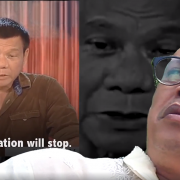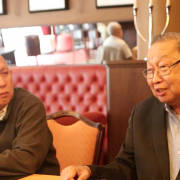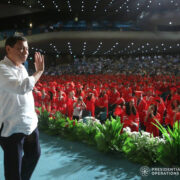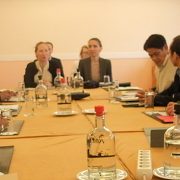To give or not to give SAP tranche 2
How many mothers have been forced to leave their little ones at home, walk far, and stand in long lines for ayuda only to go home empty-handed? How many senior citizens and persons with disability (PWD), despite their frailty and limits, still tried to get support but in vain?
What can government say to people asking: “Paano na kami, ano nang kakainin namin sa sunod? Kung ano-ano nang ginagawa sa itlog – nilalaga, sinisigang, inaadobo.”, or “Itinutulog na lang ng mga anak ko ang agahan at tanghalian, kasi pang-isang kain na lang ang meron kami.” There are countless, grimmer accounts of such despair.
As of May 16, exactly two months after Luzon and some parts of the country were put under a lockdown to contain COVID-19, the official count of beneficiaries that have not received the first tranche of social amelioration was still quite a number – 811,193 families or some 4 million people. Even if everyone gets served eventually, the point is that millions of Filipinos were made to wait that long for the much-needed aid to come. Yet the Duterte administration dilly-dallies about distributing the second tranche of the social amelioration program (SAP), as if it is an option to give or not to give.
Those who are in modified enhanced community quarantine (MECQ) areas unarguably need continued support from government. The lockdown has caused two months of difficulty in terms of jobs, livelihood and incomes.
But the over 13 million families who now fall in the category of general community quarantine (GCQ) also still need continued support. They were also under lockdown for six to eight weeks and, at best, only got a small amount of support under the first tranche. Moreover, data as of the exact second month of the lockdown showed that there were even 659,850 households in GCQ areas who have actually not yet received their first tranche. This included 189,467 households in the new GCQ areas.
There should be no question that the second tranche needs to be distributed not just in the remaining MECQ areas but in the GCQ areas as well.
Bayanihan is explicit about it
The SAP targets 17.7 million beneficiaries. The National Capital Region, Region III except Aurora and Tarlac, Laguna, Mandaue City and Cebu City are under MECQ until the end of the month, covering about 4 million beneficiaries. Erstwhile ECQ areas Benguet, Pangasinan, CALABARZON except Laguna, Ilo-ilo, Cebu, Davao City and Bacolod City now join the rest of the country under GCQ – bringing the number of SAP beneficiaries in GCQ areas up to 13.7 million.
The usual economic activities can resume in GCQ areas. There are still minimum health requirements such as physical distancing, frequent handwashing, and bodily protection because the battle against the coronavirus continues. MECQ areas meanwhile maintain restrictions on mobility outside the home, as well as on non-essential activities.
Malacañang initially announced that only MECQ areas will get the second tranche of social amelioration. Soon after, the president gave orders to not just give it all 18 million families but to actually add 5 million more, earning him additional popularity points. Yet is this really something for the president to give or not give according to how generous he is feeling?
The Bayanihan to Heal as One Law or Republic Act 11469 is actually clear. Section 4 (c) of explicitly states that the government shall “Provide an emergency subsidy to around eighteen (18) million low income households: Provided, That the subsidy shall amount to a minimum of Five thousand pesos (P5,000.00) to a maximum of Eight thousand pesos (P8,000.00) a month for two (2) months.”
Making the people wait
At the onset of the Bayanihan law, the government promised Php250 billion for social amelioration and health response. It acknowledged the huge task of strengthening the country’s health system to contain the coronavirus and to save lives. It also recognized that the lockdown would result in widespread displacement of jobs and disruption of livelihoods, badly hitting the majority of the country’s low-income households.
Two months later, there is still no consensus among scientists and medical professionals on whether or not the pandemic curve is flattening. The number of confirmed cases continues to rise, now exceeding 12,700, and also deaths at over 830 already. Our health workers and frontliners are holding the line as best as they can. But they are also the first to take the brunt amid a private sector-dominated health system that is itself ailing from a gross lack of equipment, facilities, infrastructure and manpower to deal with the pandemic.
The government owes the health sector a grand boost, in the same way that it owes the people in the GCQ areas the second tranche of SAP.
To what end
Is the administration’s dilly-dallying part of a script where, to be able to give help to now 23 million SAP beneficiaries, the government will now be forced to sell public assets to fund social amelioration? Who is buying – China?
Time and again, Malacañang has said that it doesn’t have enough funds, and that it’s only thanks to the president’s prudence that the government has found money to spend. Still, resources are limited so the people have to wait. Or even sacrifice – social welfare secretary Rolando Bautista even once said that not receiving the second tranche is perhaps actually in the spirit of Bayanihan, in freeing up resources for others.
Yet there are funds that can be tapped without the government selling off its assets. IBON estimates a universe of Php3 trillion worth of funds that can be explored and tapped. This includes: realigning Build, Build, Build and confidential and intelligence funds; realigning debt service payments by pushing for a debt moratorium, restructuring or even cancellation; and raising new revenues from issuing COVID-19 solidarity bonds and higher income taxes and wealth taxes on the super-rich.
This would indeed mean a big shift for the Duterte administration whose economic managers already have their minds set on a recovery program that pushes instead of thwarts those business-biased measures, for example, big-ticket infrastructure, tied debts, lower corporate income taxes, and tax incentives for investors. But there should be no second thoughts either about doing everything necessary to help the people survive the crisis.
Some Metro Manila local government units (LGUs) did not make people trapped in the lockdown wait for too long. They defied the apparent limitations of the bureaucracy by tapping internal funds to distribute assistance to their constituents early in the ECQ. They combined technology and people’s volunteerism to deliver help as expediently as they could.
The people have been at the center of these LGUs’ emergency relief operations. This does not seem to be the case with the Duterte administration or even its predecessors. Because, if they were, why is our health system still at a loss with COVID-19? Why can’t the government drop everything to make sure that all vulnerable households get the first and second tranche of social amelioration immediately?
Why are more hapless citizens arrested than are tested? Also, why are relief volunteers, community leaders, mobile kitchens, and even journalists – who are merely trying to fill in gaps in emergency assistance – being harassed, arrested, or even killed by law enforcers?
The huge health and economic crisis that the country is facing now can only be hurdled, humanely and effectively, if the people were heeded and not hindered from actively participating. #
= = = = =
Xandra heads IBON’s Media and Communications Department. She loves to write songs, listen to her panganay’s music and play chess with her bunso on the side.
Kodao publishes IBON articles as part of a content-sharing agreement.







